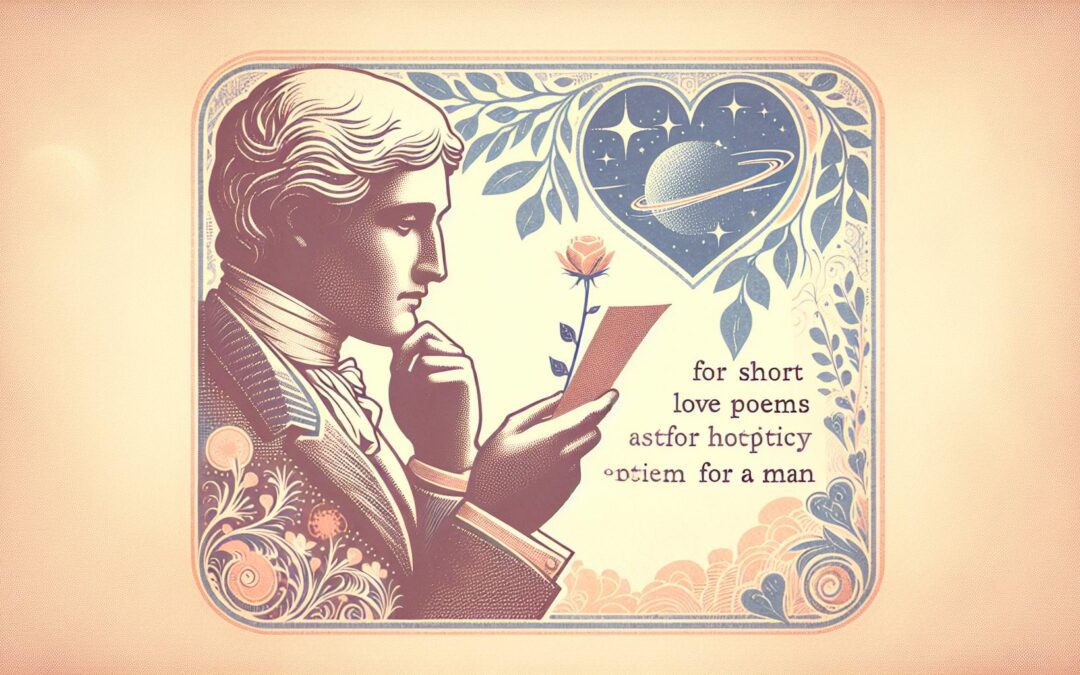Short love poems for him condense intense emotions and vivid imagery into precise, unforgettable lines. Across centuries, poets shaped new ways to honor connection and desire. The interplay of brevity and sincerity in these works unlocks layers of meaning, often crystallized in a few lines. Readers seeking inspiration for new expressions can find more examples in the Short Love Poems For Wife collection and related archives.
Historical Development and Global Traditions in Short Love Poems for Him
The earliest surviving fragments of short romantic poetry date to ancient Sumer. Royal couples exchanged cuneiform verses inscribed onto small tablets. In pharaonic Egypt, scribes wrote poems on papyri that blend gestures of affection with symbols of eternity. Ancient Chinese poets in the Tang dynasty composed quatrains, short four-line poems shaped by musical tonal patterns and Confucian ideals. These works highlight admiration and gentleness through allusion and metaphor. Across the Islamic world, poets crafted ghazals, intricate short poems usually centered on longing and devotion. Compelling examples from Sanskrit tradition, such as shlokas and dohas, focus on beauty, virtue, and friendship. Further reflection on these transcultural motifs appears in the selection of Famous Short Love Poems.
Evolution Through Literary Movements
Short love poetry developed rapidly during the European Renaissance. Petrarch’s sonnets compressed emotional conflicts into strict, measured lines, while Wyatt and other English poets shifted love lyrics into the rhythms and language of everyday speech. The Romantic era reimagined form and voice; Robert Burns, for instance, composed energetic Scottish couplets that celebrated devotion in concise stanzas. In the twentieth century, experimentation flourished. Ezra Pound translated Asian forms such as the haiku, featuring three lines and seventeen syllables, and introduced new possibilities for compression and surprise. Rabindranath Tagore’s brief poems distilled spiritual reflection and longing as part of larger cultural transformation. Relevant collections, including the Romantic Short Love Poems series, chart these innovations.
Distinguished Poets and Cultural Impact
Sappho, writing in archaic Greece, used short epigrams to cast admiration and longing toward her beloveds. In medieval Persia, Rumi and Saadi composed ghazals celebrating close male companionship. Shakespeare’s “fair youth” sonnets invite the reader to unravel coded meanings in taut, rhythmic structures. Poets from diverse backgrounds, including Langston Hughes and Pablo Neruda, transformed public ideas about masculinity through unapologetically direct and affectionate short poems. Their influence resonates in works found in thematic resources like Short Love Poems And Quotes.
Distinctive Features and Thematic Range
Short love poems for him use focused structure. Common forms include couplets—two-line verses often used for direct proclamations—and quatrains, which present a contained scene or meditation in four lines. Haiku, adopted from Japanese tradition, capture a profound moment in three lines, evoking nature and emotion with strict syllable counts. These forms amplify the intensity of individual words and images, demonstrating that intimacy can thrive within minimal space. Further guidance on form and structure appears alongside examples in the I Love You Poem Short section.
Language, Metaphor, and Symbol
A single word or phrase in an effective short love poem can carry deep significance. Physical imagery—such as describing warmth, gesture, or movement—suggests more than immediate presence. Natural symbols, including stars, rivers, and flowers, accumulate meanings linked to strength, tenderness, or endurance. Rather than stacking similes, successful poets rely on clear, particular details. In the Short Poems For Her anthology, concrete examples of these poetic devices illuminate how poets bring distant feelings close through selective imagery.
Emotional Tone and Resonance
Despite their brevity, these poems deliver powerful emotional content. A brief phrase might evoke longing, joy, or vulnerability without explicit explanation. Tone can shift from quiet admiration to playful wit. Instead of presenting a full narrative, a short poem crystallizes one vital moment, inviting readers to fill the silences with their own interpretations. The sense of immediacy is common, as seen in the Short Poems To Make Her Melt collection, where every word counts toward emotional impact.
Affection and Admiration
A hallmark of short love poems for him lies in direct, heartfelt statements. Expressions such as “You are my shelter from the storm” or “Your laughter lights my world” bring the beloved into close emotional focus. Physical attributes such as strength of hands or clarity of gaze, and personal qualities like steadfastness and humor, appear frequently. The poems do not always emphasize physical desire. Instead, they can highlight trust, companionship, and gratitude. Those seeking inspiration for new tributes might explore Poem For Him Short for more examples.
Themes of Longing, Absence, and Reunion
Distance between lovers is a major theme in many traditions. Poets use space between lines or images within a poem to suggest separation, anticipation, or loss. Absence sharpens feelings of desire and hope. Reunion appears through images of warmth, new seasons, or gentle touch rather than detailed stories. Japanese tanka poetry employs nature imagery to evoke the pain of separation and the relief of return. Additional perspectives on longing and hope can be found in the Short Poems About Heartbreak series.
Depiction of Masculine Qualities and Connection
Poets have long described male virtues in concise phrases. Writers from antiquity compared arms to those of mythic heroes and described radiant appearance by invoking sun gods. Later poets shifted emphasis toward subtlety, wisdom, and thoughtfulness. Contemporary works address vulnerability alongside strength, upending older models. Many poems portray partnership as a series of daily gestures: a reassuring glance, an inside joke, a helping hand. Nor does admiration preclude honest critique, as the best poems combine praise with gentle questioning. Interested readers can explore parallel approaches in Short Romantic Poems For Her To Make Her Cry.
Vulnerability and Intimacy
Short forms press close to moments of openness. Small details—a softened voice, a trembling hand, an unfinished thought—dismantle protective facades. Intimate poems share private truths, trusting the addressee with feelings seldom voiced aloud. The space within the poem mirrors the space between partners. Through restraint and silence, poets carve out room for intimacy, trust, and revelation. For more on vulnerability expressed through minimal language, readers can turn to Short Poems To Make Her Feel Special.
Masculinity, Identity, and Cross-Cultural Representation
Portrayals of masculinity within short love poems encompass traditional, idealized figures as well as complex, contemporary characters. Some poems from previous centuries valorize heroism, protection, or stoic endurance. Renaissance and early Romantic texts often depict men as distant or unattainable, yet deeply admired. In contrast, more recent poems highlight compassion, joy, and emotional transparency, shifting away from rigid archetypes. For insight into diverse perspectives, see Short And Sweet Poem.
Contemporary Shifts in Gender and Voice
Narrative voice and subject matter have diversified in the past several decades. New poems reflect nontraditional relationships, flexible gender roles, and direct address. Same-sex affection, transitions, or nonbinary identities all find expression in concise form, changing public perceptions about love and partnership. Language that once obscured or disguised now states openly and compassionately. Poets draw the beloved into equal proximity, not as a distant ideal but as a companion in honesty and care. These shifting dynamics are reflected in the inclusive anthologies such as Love Poems Short And Sweet.
Influence of Poet’s Identity
Who writes the poem shapes how it sounds and what it conveys. Female poets addressing male beloveds often redefine notions of agency and desire. Male poets writing about men explore both social approval and resistance, sometimes subverting expectation or celebrating bonds hidden from public view. Nonbinary or queer poets experiment with address, pronouns, and imagery in search of new modes of intimacy. These changes drive ongoing innovation, as outlined in Short Love Poems For Girlfriend.
Comparisons Among World Traditions
Western poetry typically explores psychological depth or emotional candor in short love poems for him. Shakespeare compresses episodes of affection and jealousy into memorable lines. In contrast, classical Japanese poetry favors scenes of nature, presenting the male beloved within landscapes and seasonal change. Persian traditions emphasize longing and beauty through repeated motifs and formal repetition. While cultural specifics differ, all traditions emphasize the power of a single precise phrase. Readers might compare these motifs to those found in the Beautiful Short Love Poem section.
For those wishing to read contemporary explorations of short love poems for him, or to study new forms and voices, current resources on sites like Poets.org and Poetry Foundation present ongoing scholarship and creative innovation. These platforms offer historical works alongside new interpretations, supporting both readers and aspiring poets.

